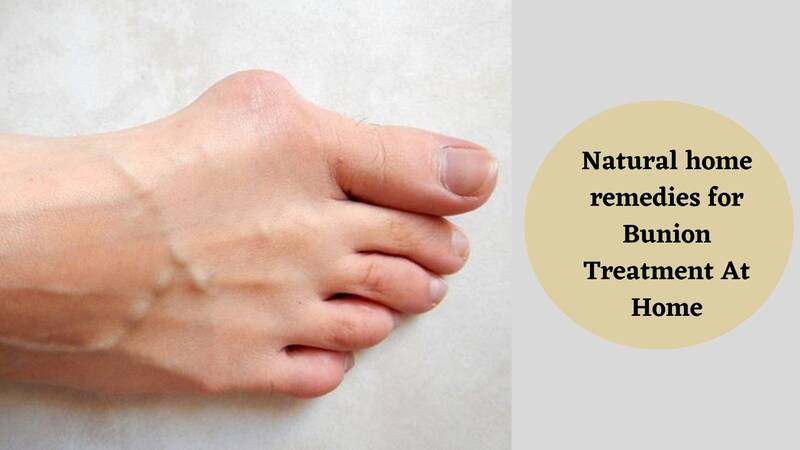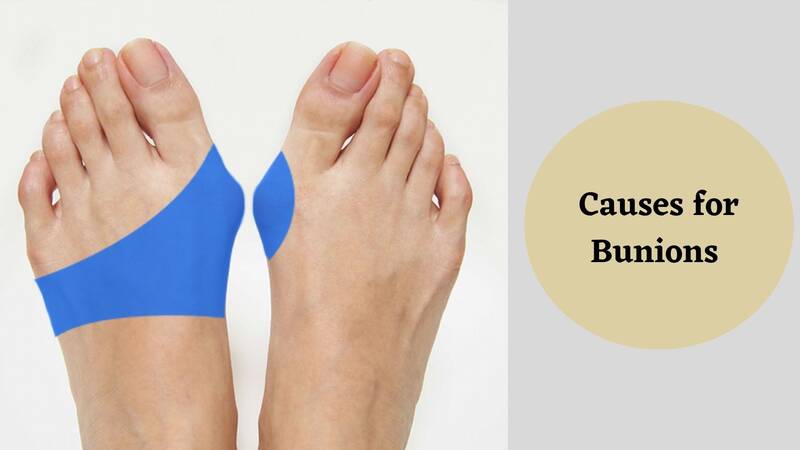Treating bunions naturally can help alleviate the pressure and pain from the bunion.
Healthcare professionals mainly recommend nonsurgical treatments for bunions unless they cause any significant issues.
Let us now check and try out the Bunion Treatment At Home procedure.
Bunions develop on your foot in an aging person. They gradually develop when the bigger toe starts leaning towards its adjacent toes, creating a distorting outlook.
At the side of the foot, a lump forms, even at the base of the bigger toes, and widens your foot’s base.
The pressure results in a few of the other toes changing their shape.
They are more likely evident in females, who are more likely to develop bunions than males.
There are natural treatments for bunions that reduce the pain and the risk of conditions that become serious.
But, surgery would be the other mode of treatment for getting rid of bunions entirely.
Continue reading to learn more about the development of bunions, natural pain relievers, and varied types of surgeries!
Contents
Natural Home Remedies for Bunion Treatment At Home

If a person suspects the development of a bunion on their foot, they should take their doctors’ advice for suggestions.
Atypical foot conditions are treated by podiatrists who suggest ways to reduce the pain arising from a bunion or reduce its growth.
The following are the treatments that you can try out:
Wear wider shoes
Several of the symptoms related to the bunions are caused by pressure from the shoes on your bunions.
The common adverse effects are direct discomfort over your bunions, redness, stiffness, as well as blistering.
Wearing wider shoes can help relieve the strain on your foot since the smaller ones will force your bigger toes in.
Choose flats with lots of toe space.
Always avoid the shoes with taller heels and the ones with smaller, pointed, and restrictive heels at all costs.
If you require some new shoes, go to a store with skilled shoe fitters who can size your feet.
A trained shoe fitter can not only help you choose the better shoes, but they can also alter the footwear to fit complicated feet.
Get shoes with better arch support
The force would be transferred away from the bunion area by supporting the arch.
However, a higher quality pre-made orthotic can come as a rescue, but it will not be as effective as the custom ones.
You can try out a few brands that can also help you save some bucks and enter into the store-bought route.
Wear sandals with arch support
It is somewhat similar to the concept we discussed earlier.
Avoid wearing any narrow footwear that does not have arch support.
Narrow slippers shrink your bigger toe leading to excessive friction over the bunion.
Arch support can also help in reducing the immense amount of pressure on your bunions.
Wear socks as an added cushion for reducing friction
Socks that are made out of cotton are never a good option since they cause increasing friction.
Also, avoid socks with seams across your toes.
This leads to pain and friction, so make sure you try out the seamless socks.
These are made with a combination of spandex and wool.
There are also compression socks that can help in avoiding friction.
Always avoid compression socks since you do not wish to restrict the flow of blood to the feet if you have diabetes.
Wear protective pads to reduce pressure on bunions
Pressure gets redistributed away from the joint that is affected with the help of the bunion pads.
Ensure to test these pads for a shorter period to make sure that they can help reduce pressure instead of constricting the toes even more, making the bunion bump worse.
Use toe separators
A toe separator between the first and the second toe will prevent them from rubbing each other.
There are toe spacers that are the best when the bigger toes deviate and in the early development of the bunions before the bigger toes get fixated in a position.
It can surely help straighten out the toe joint while you wear them, although it will not heal or reverse the bunions.
Use a Topical Pain Reliever
Topical pain relievers can help reduce inflammation and pain in the short term.
One of the instances is Biofreeze, a prominent therapy that works effectively in easing pain by reducing the flow of blood and temporarily disorienting the pain tremors.
Biofreeze is applied to the bunion about four times each day to ease the causes of pain.
Bunion Splints
Either the first or second toes are prevented from rubbing against each other with bunion splints.
This relieves part of the pain produced by the bunion by reducing the pressure between the toes.
It is suggested that you use it here at night while sleeping.
There are, in our opinion, better options for reducing bunion discomfort, such as those described above.
However, some companies have discovered that bunion splints are a good short-term treatment.
Although several goods online offer “bunion repair,” there is no proof that bunion splints would correct or elevate the toe.
Apply Ice to reduce soreness
Swelling can be reduced, and discomfort can be eased with the application of Ice.
Always ice your foot for about 20 minutes.
Wrap the Ice with a pack in a towel to avoid placing the Ice in direct contact with your skin.
After applying the Ice, keep your foot elevated above your heart to encourage the flow of fluid away from the limbs, thereby reducing the swelling.
Read– Does Nutritional Yeast Go Bad?
Knowing about bunions
Are you searching for any home remedies for decreasing the pain in bunions?
A bunion is considered a typical deformity on the foot, occurring as a bump over the joint where your bigger toe will meet your foot which is also termed an MTP joint.
Bunions are known as hallux abductor valgus medically, especially for medical professionals.
It will shrink your bigger toe at times to the point where it would move on top of the toe adjacent to it.
It can become redder and inflamed. Bunions are painful, and it is tough to move your bigger toe.
There are a few home remedies that you can try out to reduce the pain caused by bunions.
However, the others are treated with surgeries.
Causes for Bunions

People have started noticing bunions between the ages of 20 and 30s, mainly in the U.S. Surely, they happen later or even before that.
When the MTP joint on your foot faces the enduing pressure with time, bunions develop. However, the joint moves away from its typical alignment leading to the formation of a bony bump.
The following are the issues underlying the formation of bunions:
- The shape of your foot subjected to genetic problems
- Improper fittings of your shoes, mainly the one that cramps your toes
- If you face rheumatoid arthritis or inflammatory diseases.
Read– Coconut Oil For Scars
How effective are the natural remedies for bunions?
Natural remedies can help prevent the development of bunions, therefore, alleviating the swelling and pain that comes with it. But, they can hardly correct any type of underlying causes.
The other option for treating bunions is surgery. However, doctors would recommend it if:
- You have a serious pain
- It hinders your daily activities
- Natural remedies are not effective
Additional note on bunions
As noted by professional institutes in the United States, bunions are extremely common, affecting over 60 million Americans.
A bunion is a skeletal protrusion from the joint connecting your big toe and foot.
The bottom of your big toe bone moves upward as the top moves towards another toe, causing the joint to enlarge.
Doctors aren’t certain what bunions are, but they believe that issues with foot structure, such as overpronation, allow your body weight to redistribute, putting pressure on the big toe joint. The bone moves as a result of the increasing pressure.
Doctors believe it is also partly inherited.
Read– Echinacea Benefits For Skin
FAQs
Below we share some FAQs related to the Query “Bunion Treatment At Home”
1. Is bunion treatable at home?
You have several at-home remedies for bunions, but surgery is recommended to get rid of them before they worsen in severe cases.
But, always remember that the first step is to treat the bunions without any surgery.
2. Can bunions be pushed back?
Toe separators or bunion splints can be used for gradually restoring your foot to its natural position, therefore, reversing the motion that pushes the bunion out.
The bunions start receding once your toes spread out.
3. Can you get rid of bunions?
The bunion will not go rid of itself; it will only get worse as you get older.
A small bunion may well not be unpleasant at first, but it can later cause discomfort in the big toe joint and make shoe fitting problematic.
4. What if you don’t cure a bunion?
A bunion eventually leads to arthritis if left untreated, especially if the big toe joint has undergone substantial, long-term damage.
Bunions can cause the cartilage to degrade in the joint. Bunions can be treated surgically, but arthritis and the likelihood of persistent discomfort are not.
5. What causes bunions in people?
Bunions can be caused or made worse by wearing tight, narrow shoes.
Bunions can also arise as a result of your foot’s shape, a deformity, or a health condition like arthritis.
On the knuckle of your little toe, smaller bunions (bunionettes) might form.
6. Does walking make bunions worse?
A bunion is a painful bony bulge outside the big toe caused by physical from the method you stride or your foot shape.
Bunion discomfort can be exacerbated by wearing narrow shoes while standing for lengthy periods.
If bunion patches, toe spacers, and effective shoes don’t help (a bunionectomy), you may require surgery.
7. Can bunions be treated using toe spacers?
There are several nonsurgical therapies for bunions, but it is really important to remember that they only cure the symptoms, not the deformity.
Bunion pads, toe separators, and bunion splints are examples of these solutions to help reposition the foot to its natural position.
8. What causes bunions to ache at night?
Bunions are terrible enough while walking or when wearing too-tight shoes. Furthermore, nerves that have been squeezed by the skeletal growth frequently fire at night, causing pain and throbbing.
9. Which is the age when bunions can develop?
People can gradually start to notice the bunions in their 20s and 30s in the U.S. and several other societies that wear shoes. However, it can also start out early.
10. Does walking help in getting rid of bunions?
It can offer you a subtle foot massage and also aid in strengthening your toes.
It is noted that it is beneficial for individuals with arthritis that is often associated with bunions.
Read– Heel Pain From Running
Summary
- Bunion Treatment At Home is possible, although it may not heal on its own as pain can be alleviated with natural bunion treatment and the pressure it causes. Speak to your physician if the bunions cause persistent serious pain and related issues.
- People use padding for wearing shoes for comfort, which can help in reducing pressure on the bigger toes. Podiatrists may even recommend the orthotics making shoes more supportive and comfortable.
- An individual can help strengthen the muscles around your foot more than the ones that cause pressure on your foot following regular exercises.
- Your physician may be recommending surgery to treat serious bunions by straightening out the toes and reshaping the bigger toe joint.
Read– Are Beets Good For Diabetes
- Understanding HIPAA Compliance: Obligations for Covered Entities and Business Associates - April 23, 2024
- Things to Invest in for the Easter Season in 2024 - March 29, 2024
- Why Experience Matters: Finding An Established Dental Implants Provider - March 29, 2024
